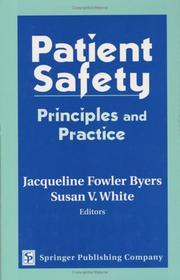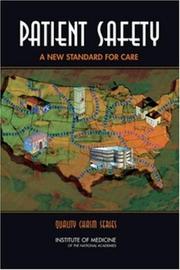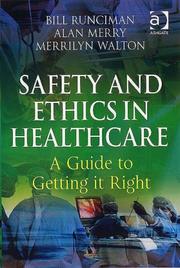| Listing 1 - 10 of 21 | << page >> |
Sort by
|
Book
ISBN: 311034033X 3110382466 9783110340334 3110337053 Year: 2015 Publisher: Berlin ; Boston : De Gruyter,
Abstract | Keywords | Export | Availability | Bookmark
 Loading...
Loading...Choose an application
- Reference Manager
- EndNote
- RefWorks (Direct export to RefWorks)
Patient safety is a basic patient right as well as a duty for medical providers. Preventive measures in diagnostic, therapeutic, and nursing care are diverse and must be adapted to each situation. For the first time, the book presents an up-to-date and interdisciplinary view on patient safety and clinical risk management for ambulatory and inpatient care organized according to the WHO "Patient Safety Curriculum Guide." Patienten im stationären und ambulanten Gesundheitswesen erwarten eine interprofessionell organisierte Versorgung in Diagnostik, Therapie und Pflege, die sich am aktuellen Stand von Wissenschaft und Forschung orientiert. Diese Versorgung muss frei von vermeidbaren Risiken und Gefahren erfolgen. Das Buch gibt einen umfassenden Überblick über Möglichkeiten, Forschungsergebnisse und anwendbare Präventionsmaßnahmen für Klinik und Praxis aus interprofessionell klinischer, psychologischer, betriebswirtschaftlicher, technischer sowie juristischer Perspektive. Es orientiert sich dabei am Curriculum der WHO und empfiehlt sich damit als Lehrbuch zum Thema Patientensicherheitsmanagement. Der Leser erhält anhand von interdisziplinärenTheorie- und Denkansätzen, Anwendungsbeispielen, Checklisten und anderen Instrumenten Hilfestellung bei der Implementierung von Patientensicherheitsstrategien in den Versorgungsalltag. Ein Autorenteam von über 60 ausgewiesenen Experten hat an diesem Buch mitgewirkt.
Medical errors. --- Patient safety. --- Errors, Medical --- Medical mishaps --- Mishaps, Medical --- Errors, Scientific --- Medicine --- Practice
Book
ISBN: 0191773689 0191649554 9780191649554 1306411963 9781306411967 0191649562 Year: 2014 Publisher: New York, New York : Oxford University Press,
Abstract | Keywords | Export | Availability | Bookmark
 Loading...
Loading...Choose an application
- Reference Manager
- EndNote
- RefWorks (Direct export to RefWorks)
The majority of errors, litigation, and complaints in the health service are due to 'human factors', yet the term is still not widely understood and is sometimes used interchangeably to refer to team training or communication skills. Although including these, the subject of 'human factors' goes far beyond this to look at systems, environmental influences, and interactions with equipment, in addition to self-awareness and human interaction. All of these aspects are captured inHuman Factors in Healthcare and are built into a new framework: the SHEEP model, which breaks down into five key areas:
Medical errors. --- Patients. --- Persons --- Sick --- Errors, Medical --- Medical mishaps --- Mishaps, Medical --- Errors, Scientific --- Medicine --- Practice
Book
ISBN: 9780833089281 0833089285 Year: 2014 Publisher: Santa Monica, California : RAND Corporation,
Abstract | Keywords | Export | Availability | Bookmark
 Loading...
Loading...Choose an application
- Reference Manager
- EndNote
- RefWorks (Direct export to RefWorks)
Medical errors --- Patients --- Prevention. --- Safety measures. --- Persons --- Sick --- Errors, Medical --- Medical mishaps --- Mishaps, Medical --- Errors, Scientific --- Medicine --- Practice

ISBN: 128181332X 9786611813321 0826133479 9780826133472 9781281813329 9780826133465 0826133460 0826133460 6611813322 Year: 2004 Publisher: New York, NY : Springer,
Abstract | Keywords | Export | Availability | Bookmark
 Loading...
Loading...Choose an application
- Reference Manager
- EndNote
- RefWorks (Direct export to RefWorks)
This book provides readers with both a foundation of theoretical knowledge regarding patient safety as well as evidence-based strategies for preventing errors in various clinical settings. The authors' goal is to help clinicians and administrators gain the skills and knowledge they need to develop safe patient practices in their organizations. Key topics include:.: An overview of evidence-based best practices for patient safety; Clear explanation of important patient safety policies and legislation; Innovative uses of technology such as computerized provider order entry, barcoding medications,
Medical errors --- Medical care --- Health services administration --- Errors, Medical --- Medical mishaps --- Mishaps, Medical --- Errors, Scientific --- Medicine --- Prevention. --- Quality control. --- Practice
Book
ISBN: 0309221129 9786613558077 0309221137 1280380160 9780309221139 9781280380167 9780309221122 6613558079 0309221153 9780309221153 Year: 2012 Publisher: Washington, D.C. : National Academies Press,
Abstract | Keywords | Export | Availability | Bookmark
 Loading...
Loading...Choose an application
- Reference Manager
- EndNote
- RefWorks (Direct export to RefWorks)
Medical Errors --- Hospitals & Medical Centers --- Medical errors --- Errors, Medical --- Medical mishaps --- Mishaps, Medical --- Health facilities --- Medical care --- Medical informatics --- Prevention. --- Quality control. --- Errors, Scientific --- Medicine --- Practice
Book
ISBN: 1617051608 9781617051609 193628796X 9781936287963 Year: 2013 Publisher: New York, NY : Demos Medical Pub.,
Abstract | Keywords | Export | Availability | Bookmark
 Loading...
Loading...Choose an application
- Reference Manager
- EndNote
- RefWorks (Direct export to RefWorks)
As with other volumes in the Diagnostic Standards of Care series, Transfusion Medicine focuses specifically on understanding potential problems and sources of error in management of the blood bank and transfusion, how to anticipate and avoid such problems, and how to manage them if they occur. The discussions are concise, practical, specific, and problem-based so the book directly addresses the situations and issues faced by the clinical pathologist or other manager or staff member of the blood bank team. Discussion of each problem is augmented by a case discussion giving a real-world example
Diagnosis, Laboratory. --- Medical errors. --- Errors, Medical --- Medical mishaps --- Mishaps, Medical --- Errors, Scientific --- Medicine --- Clinical medicine --- Clinical pathology --- Diagnostic laboratory tests --- Laboratory diagnosis --- Laboratory medicine --- Medical laboratory diagnosis --- Diagnosis --- Pathology --- Practice
Book
ISBN: 1421429098 9781421429090 9781421429083 142142908X Year: 2019 Publisher: Baltimore : Johns Hopkins University Press,
Abstract | Keywords | Export | Availability | Bookmark
 Loading...
Loading...Choose an application
- Reference Manager
- EndNote
- RefWorks (Direct export to RefWorks)
Developing best practices and ethical systems to protect and enhance patient safety.Human errors occur all too frequently in medical practice settings. One sobering recent report claimed that medical errors are the third leading cause of death in the United States. Hoping to reverse this disturbing trend but wondering why it is that things usually go well despite errors, John D. Banja's Patient Safety Ethics lays out a model that advocates vigilance, mindfulness, compliance, and humility as core ethical principles of patient safety.Arguing that the safe provision of healthcare is one of the most fundamental moral obligations of clinicians, Banja surveys the research literature on harm-causing medical errors to explore the ethical foundations of patient safety and to reduce the severity and frequency of medical error. Drawing on contemporary scholarship on quality improvement, risk management, and medical decision making, Banja also relies on a novel source of information to illustrate patient safety ethics: medical malpractice suits.Providing professional perspective with insights from prominent patient safety experts, Patient Safety Ethics identifies hazard pitfalls and suggests concrete ways for clinicians and regulators to improve patient safety through an ethically cultivated program of "hazard awareness". [Summary from bookseller's website.]
Quality of Health Care --- Patient Safety --- Medical Errors --- Ethics, Clinical --- Errors, Medical --- Medical mishaps --- Mishaps, Medical --- Errors, Scientific --- Medicine --- ethics --- Practice --- Ethics, Medical. --- Medical Ethics --- Professionalism --- Bioethics --- Patient Safeties --- Safeties, Patient --- Safety, Patient --- Risk Management --- Patient Safety. --- ethics.

ISBN: 128017675X 9786610176755 0309529328 9780309529327 0309090776 9780309090773 Year: 2004 Publisher: Washington, D.C. : National Academies Press,
Abstract | Keywords | Export | Availability | Bookmark
 Loading...
Loading...Choose an application
- Reference Manager
- EndNote
- RefWorks (Direct export to RefWorks)
Medical records --- Medical informatics. --- Medical errors --- Standards --- Data processing --- Errors, Medical --- Medical mishaps --- Mishaps, Medical --- Clinical informatics --- Health informatics --- Medical information science --- Clinical records --- Health records --- Hospital medical records --- Patient care records --- Errors, Scientific --- Medicine --- Information science --- Communication in medicine --- Hospital records --- Practice

ISBN: 1315607441 1317060008 1317060016 1281098868 9786611098865 0754686000 9780754686002 0754644359 9780754644354 0754644375 9780754644378 9781315607443 9781317059998 Year: 2007 Publisher: Aldershot, England ; Burlington, VT : Ashgate,
Abstract | Keywords | Export | Availability | Bookmark
 Loading...
Loading...Choose an application
- Reference Manager
- EndNote
- RefWorks (Direct export to RefWorks)
A single coherent source of information on the various interlinking domains of patient safety, litigation and ethical behaviour, based on accounts of real-life situations and intended for all healthcare students, specialists and administrators.
Medical ethics. --- Clinical medicine --- Medical errors. --- Health services accessibility. --- Access to health care --- Accessibility of health services --- Availability of health services --- Medical care --- Errors, Medical --- Medical mishaps --- Mishaps, Medical --- Errors, Scientific --- Medicine --- Biomedical ethics --- Clinical ethics --- Ethics, Medical --- Health care ethics --- Bioethics --- Professional ethics --- Nursing ethics --- Social medicine --- Decision making. --- Access --- Practice --- Moral and ethical aspects
Book
ISBN: 0429266111 0429556616 9780429266119 9780429561085 0429561083 9780429565557 0429565550 9780429556616 9780367217914 9781032176826 Year: 2019 Publisher: New York : Routledge,
Abstract | Keywords | Export | Availability | Bookmark
 Loading...
Loading...Choose an application
- Reference Manager
- EndNote
- RefWorks (Direct export to RefWorks)
"This book is a collection of original, interdisciplinary essays on the topic of medical error. Given the complexities of understanding, preventing, and responding to medical error in ethically responsible ways, the scope of the book is fairly broad. The contributors include top scholars and practitioners working in bioethics, communication, law, medicine and philosophy. Their contributions examine preventable causes of medical error, disproportionate impacts of errors on vulnerable populations, disclosure and apology after discovering medical errors, and ethical issues arising in specific medical contexts, such as radiation oncology, psychopathy, and palliative care. They also offer practical recommendations for respecting autonomy, distributing burdens and benefits justly, and minimizing injury to patients and other stakeholders. Ethics and Error in Medicine will be of interest to a wide range of researchers, students, and practitioners in bioethics, philosophy, communication studies, law, and medicine who are interested in the ethics of medical error"--
Medical ethics. --- Biomedical ethics --- Clinical ethics --- Ethics, Medical --- Health care ethics --- Medical care --- Medicine --- Bioethics --- Professional ethics --- Nursing ethics --- Social medicine --- Moral and ethical aspects --- Medical errors --- Ethics, Medical. --- Medical Errors --- Moral and ethical aspects. --- ethics. --- Medical Ethics --- Professionalism --- Errors, Medical --- Medical mishaps --- Mishaps, Medical --- Errors, Scientific --- ethics --- Practice --- Medical ethics --- Professional ethics. Deontology --- Human medicine
| Listing 1 - 10 of 21 | << page >> |
Sort by
|

 Search
Search Feedback
Feedback About UniCat
About UniCat  Help
Help News
News